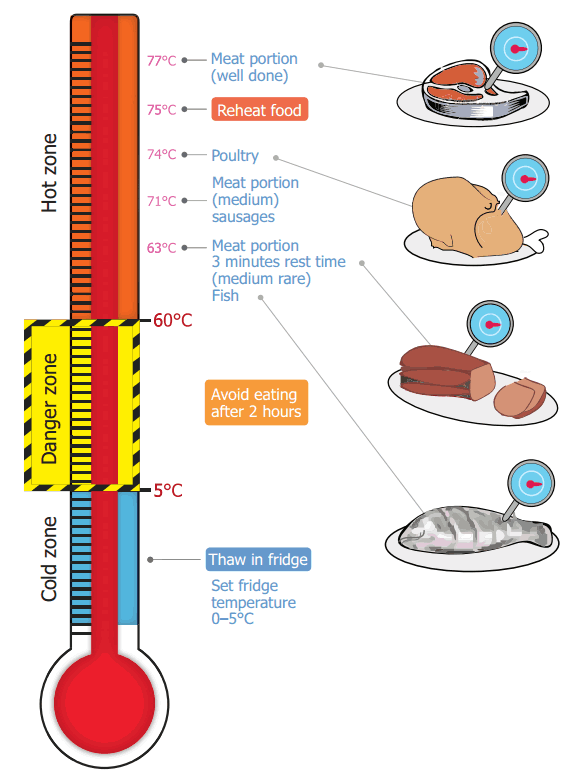Kitchen Thermometers Essential for Food Safety
TEXARKANA, Ark. –
Kitchen thermometers are a kitchen tool everyone should have in their utensil drawer and use regularly. They are essential when cooking meat, poultry, and egg products to prevent undercooking, know that your food has reached a safe minimum internal temperature, and also to prevent foodborne illness.
It is the only reliable way to determine that your meat, poultry, and egg products are cooked to the correct temperature. Most pathogens are destroyed between 140 and 165 °F.
Unfortunately, research shows that many consumers judge the color of the food to see if it is done instead of using the most reliable method of a thermometer. Some say they go by recommended cooking times, and trust their experience and judgment. This can be misleading and wrong. Let’s look at cooking hamburgers for instance. One out of four hamburgers turn brown in the middle before reaching a safe internal temperature of 160 degrees F. so color isn’t always the best indicator.
So how do you decide what thermometer is best for you? There are numerous reliable thermometers on the market today; many which are inexpensive. Digitals, instant-reads, probes for the oven and microwave, disposable indicators and sensor sticks, pop-ups, and even barbecue forks are everywhere. They are high-tech and easy to use.
The Dial Oven-Safe thermometer reads in 1-2 minutes. Place it 2 to 2 1/2 inch deep in thickest part of food. It is generally used in roasts, casseroles, and soups. This thermometer is safe to leave in the food while cooking.
The Digital Instant-Read gives a reading in 10 seconds. Place at least 1/2 inch deep away from the bone. This one can be used to measure both thick foods such as roasts and thin foods, such as soups. It is not designed to remain in the food during the cooking process.
Convenient for grilling is the Thermometer-Fork Combination. It reads in 2-10 seconds. Place at least 1/4 inch deep in thickest part of food. It can be used in most foods, but is not meant to remain in foods while it is cooking.
The Dial Instant-Read reads in 15-20 seconds. Place it 2 to 2 1/2 inch deep in thickest part of food. The temperature is averaged along the probe, from the tip to 2-3 inches up the stem; therefore, it must be inserted sideways. It can be used in roasts, casseroles, and soups
A pop-up thermometer is commonly used in turkeys and roasting. These one-time use thermometers pop up when the food reaches final temperature for safety and doneness. It is recommended to check the temperature in other parts of the food with a conventional thermometer as well.
Using a food thermometer is the only sure way of knowing if your food has reached a high enough temperature to destroy food borne bacteria.
So the next time you are wondering if something is done, reach for the thermometer that works best for you.
For your free chart to know the final temperature of most foods, click Don't Trust the Sniff Test or contact the Miller County Extension Office, 870-779-3609 or visit us in room 215 at the Miller County Courthouse. We're online at chadley@uada.edu, on Facebook at UAEXMillerCountyFCS/CarlaHaleyHadley, on Twitter @MillerCountyFCS or on the web at uaex.uada.edu/Miller.
By Carla Haley-Hadley
County Extension Agent - FCS
The Cooperative Extension Service
U of A System Division of Agriculture
Media Contact: Carla Haley-Hadley
County Extension Agent - FCS
U of A Division of Agriculture
Cooperative Extension Service
400 Laurel Street, Suite 215 Texarkana AR 71854
(870) 779-3609
chadley@uada.edu
Related Links
The Arkansas Cooperative Extension Service is an equal opportunity institution. If
you require a reasonable accommodation to participate or need materials in another
format, please contact your County Extension office (or other appropriate office)
as soon as possible. Dial 711 for Arkansas Relay.
Pursuant to 7 CFR § 15.3, the University of Arkansas System Division of Agriculture
offers all its Extension and Research programs and services (including employment)
without regard to race, color, sex, national origin, religion, age, disability, marital
or veteran status, genetic information, sexual preference, pregnancy or any other
legally protected status, and is an equal opportunity institution.
